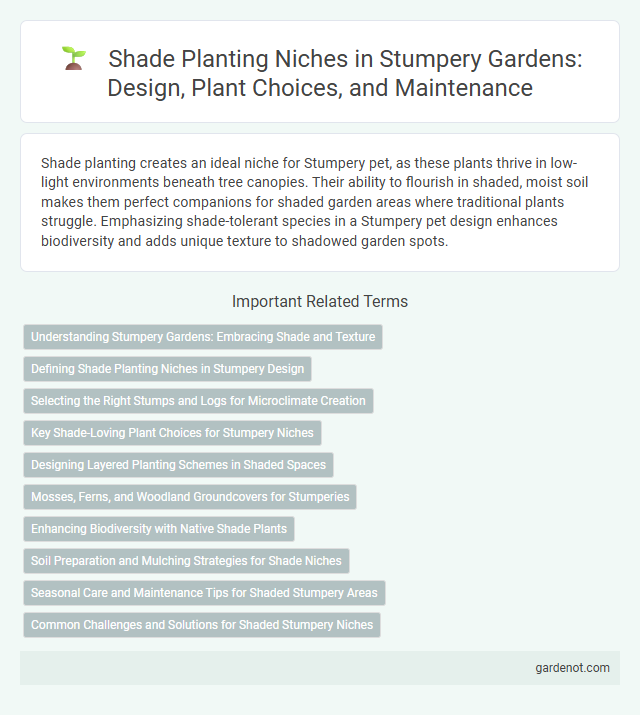Shade planting creates an ideal niche for Stumpery pet, as these plants thrive in low-light environments beneath tree canopies. Their ability to flourish in shaded, moist soil makes them perfect companions for shaded garden areas where traditional plants struggle. Emphasizing shade-tolerant species in a Stumpery pet design enhances biodiversity and adds unique texture to shadowed garden spots.
Understanding Stumpery Gardens: Embracing Shade and Texture
Stumpery gardens create a unique shade planting niche by combining decayed tree stumps with shade-loving plants such as ferns, hostas, and hellebores to enhance texture and depth. These gardens emphasize natural decomposition and organic forms, promoting biodiversity and a woodland aesthetic in shady areas. Integrating rough wood textures with lush foliage provides a dynamic contrast that thrives in low-light environments.
Defining Shade Planting Niches in Stumpery Design
Shade planting niches in stumpery design create microhabitats where shade-tolerant plants thrive amid decaying wood structures. These niches optimize moisture retention and diffuse sunlight, fostering ideal conditions for ferns, mosses, and shade-loving perennials. Integrating diverse shade planting niches enhances biodiversity and adds layered textures to the stumpery landscape.
Selecting the Right Stumps and Logs for Microclimate Creation
Choosing stumps and logs with varied sizes and textures enhances the microclimate by providing diverse moisture retention and thermal properties ideal for shade-loving plants. Decaying wood from hardwood species like oak or ash supports beneficial fungi and insects, enriching soil fertility and promoting plant health. Positioning stumps to create natural windbreaks and moisture reservoirs optimizes humidity and temperature stability for thriving shade garden ecosystems.
Key Shade-Loving Plant Choices for Stumpery Niches
Key shade-loving plants ideal for stumpery niches include ferns, hostas, and astilbes, which thrive in low-light, moist conditions commonly found in these garden features. Ferns such as Polystichum and Dryopteris offer texture and lush greenery, while hostas provide broad, variegated leaves that enhance visual interest. Astilbes add vibrant, feathery plumes that contrast beautifully with the rustic wood elements of stumperies.
Designing Layered Planting Schemes in Shaded Spaces
Designing layered planting schemes in shaded spaces involves selecting shade-tolerant species such as ferns, hostas, and astilbes to create textural and visual diversity. Incorporating varied heights, foliage shapes, and seasonal interest enhances depth and complexity within the stumpery. Utilizing groundcovers like ajuga or lamium fills lower strata, while mid and upper layers feature shrubs or small trees adapted to low light conditions.
Mosses, Ferns, and Woodland Groundcovers for Stumperies
Mosses, ferns, and woodland groundcovers thrive in the shaded, moist environments ideal for stumperies, creating lush, textured layers that enhance naturalistic garden designs. Shade-tolerant mosses like Hypnum and Sphagnum species anchor the base, while ferns such as Dryopteris and Athyrium add vertical interest with their delicate fronds. Woodland groundcovers including Epimedium and Tiarella provide seasonal blooms and dense foliage, promoting biodiversity and soil health beneath fallen logs and stumps.
Enhancing Biodiversity with Native Shade Plants
Native shade plants in stumperies create thriving microhabitats that support local wildlife, enhancing biodiversity by providing food and shelter for pollinators, birds, and insects. Incorporating species like ferns, hostas, and woodland wildflowers optimizes soil health and promotes ecological balance in shaded garden niches. Selecting region-specific native shade plants strengthens ecosystem resilience by maintaining genetic diversity and adapting naturally to local environmental conditions.
Soil Preparation and Mulching Strategies for Shade Niches
Soil preparation for shade niches involves incorporating organic matter such as compost or leaf mold to improve moisture retention and aeration in low-light environments. Applying a thick layer of mulch, like shredded bark or leaf mulch, helps maintain consistent soil moisture, suppress weeds, and regulate temperature around shade-loving plants. Well-prepared soil combined with effective mulching techniques fosters healthy root development and supports diverse shade-tolerant plant growth in stumpery designs.
Seasonal Care and Maintenance Tips for Shaded Stumpery Areas
Shaded stumpery areas require careful seasonal care to maintain plant health and aesthetic appeal. During spring, prune shade-tolerant perennials like hostas and ferns to encourage new growth, while removing debris reduces fungal risks in damp conditions. In autumn, apply mulch to retain moisture and protect roots, and monitor for pests that thrive in low-light environments to ensure thriving shade planting niches.
Common Challenges and Solutions for Shaded Stumpery Niches
Shaded stumpery niches often face challenges such as limited sunlight, poor air circulation, and soil moisture retention issues, which can hinder plant growth. Selecting shade-tolerant species like ferns, hostas, and hellebores helps overcome low light conditions, while incorporating well-draining, organic-rich soil improves moisture balance. Regular pruning and strategic spacing enhance airflow, reducing fungal diseases common in dense shade environments.
Shade planting niche Infographic

 gardenot.com
gardenot.com